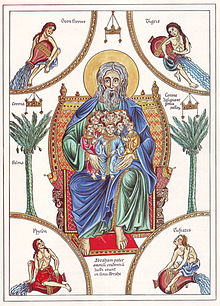Patriarchs (Bible)

The Patriarchs (Hebrew: אבות Avot or Abot, singular Hebrew: אב Ab or Aramaic: אבא Abba) of the Bible, when narrowly defined, are Abraham, his son Isaac, and Isaac's son Jacob, also named Israel, the ancestor of the Israelites. These three figures are referred to collectively as the patriarchs of Judaism, and the period in which they lived is known as the patriarchal age. They play significant roles in Hebrew scripture during and following their lifetimes. They are used as a significant marker by God in revelations[1] and promises,[2] and continue to play important roles in the Abrahamic faiths. More widely, the term Patriarchs can be used to refer to the twenty ancestor-figures between Adam and Abraham. The first ten of these are called the Antediluvian patriarchs, because they came before the Flood. Judaism and Islam hold that the patriarchs and their primary wives – Sarah (wife of Abraham), Rebekah (wife of Isaac) and Leah (one of the wives of Jacob) – (known as the Matriarchs), are entombed at Machpelah in Hebron, a site held holy by Jews, Muslims, and Christians. Only Rachel, Jacob's favorite wife, is said to be buried separately in the Tomb of Rachel, near Bethlehem, where she is believed to have died in childbirth. More broadly, the term can also refer to any of the major figures of the Book of Genesis, including the lineage of Adam, before the Great Flood, and the lineage of Noah to repopulate the earth after the Flood.
Antediluvian patriarchs
The lifetimes given for the patriarchs in the Book of Genesis are: Adam 930 years, Seth 912, Enos 905, Kenan 910, Mahalalel 895, Jared 962, Enoch 365 (did not die, but was taken away by God), Methuselah 969, Lamech 777, Noah 950.[3] The lifespans given cause problems of chronology for Bible scholars, as the following quotation shows.
"The long lives ascribed to the patriarchs cause remarkable synchronisms and duplications. Adam lived to see the birth of Lamech, the ninth member of the genealogy; Seth lived to see the translation of Enoch and died shortly before the birth of Noah. Noah outlived Abram’s grandfather, Nahor, and died in Abram’s sixtieth year. Shem, Noah’s son, even outlived Abram. He was still alive when Esau and Jacob were born!"[4]

Explanation of color-codes:
- Lifespans recorded in the Septuagint: Black (▄▄) and gray (▄▄)[note 1]
- Lifespans recorded in the Syriac Peshitta: Gold (▄▄), yellow (▄▄), and brown (▄▄)
- Lifespans recorded in the Masoretic text: Crimson (▄▄), vermilion (▄▄), and cinnabar (▄▄)
- ^ Methuselah survived the flood according to the Septuagint (but not the Masoretic text or Syriac Peshitta), even though he was not on Noah's Ark.[5]
Family tree
| Family of Patriarchs (Bible) | |||||||||||||||||||||||||||||||||||||||||||||||||||||||||||||||||||||||||||||||||||||||||||||||||||||||||||||||||||||||||||||||||||||||||||||||||||||||||||||||||||||||||||||||||||||||||||||||||||||||||||||||||||||||||||||||||||||||||||||||||||||||||||||||||||||||||||||||||||||||||||||||||||||||||||||||||||||||||||||||||||||||||||||||||||||||||||||||||||||||||||||||||||||||||||||||||||||||||||||||||||||||||||||||||||||||||||||||||||||||||||||||||||||||||||||||||||||||||||||||||||||||||||||||||||||||||||||||||||||||||||||||||||||||||||||||||||||||||||||||||||||||||||||||||||||||||||||||||||||||||||||||||||||||||||||||||||||||||||||||
|---|---|---|---|---|---|---|---|---|---|---|---|---|---|---|---|---|---|---|---|---|---|---|---|---|---|---|---|---|---|---|---|---|---|---|---|---|---|---|---|---|---|---|---|---|---|---|---|---|---|---|---|---|---|---|---|---|---|---|---|---|---|---|---|---|---|---|---|---|---|---|---|---|---|---|---|---|---|---|---|---|---|---|---|---|---|---|---|---|---|---|---|---|---|---|---|---|---|---|---|---|---|---|---|---|---|---|---|---|---|---|---|---|---|---|---|---|---|---|---|---|---|---|---|---|---|---|---|---|---|---|---|---|---|---|---|---|---|---|---|---|---|---|---|---|---|---|---|---|---|---|---|---|---|---|---|---|---|---|---|---|---|---|---|---|---|---|---|---|---|---|---|---|---|---|---|---|---|---|---|---|---|---|---|---|---|---|---|---|---|---|---|---|---|---|---|---|---|---|---|---|---|---|---|---|---|---|---|---|---|---|---|---|---|---|---|---|---|---|---|---|---|---|---|---|---|---|---|---|---|---|---|---|---|---|---|---|---|---|---|---|---|---|---|---|---|---|---|---|---|---|---|---|---|---|---|---|---|---|---|---|---|---|---|---|---|---|---|---|---|---|---|---|---|---|---|---|---|---|---|---|---|---|---|---|---|---|---|---|---|---|---|---|---|---|---|---|---|---|---|---|---|---|---|---|---|---|---|---|---|---|---|---|---|---|---|---|---|---|---|---|---|---|---|---|---|---|---|---|---|---|---|---|---|---|---|---|---|---|---|---|---|---|---|---|---|---|---|---|---|---|---|---|---|---|---|---|---|---|---|---|---|---|---|---|---|---|---|---|---|---|---|---|---|---|---|---|---|---|---|---|---|---|---|---|---|---|---|---|---|---|---|---|---|---|---|---|---|---|---|---|---|---|---|---|---|---|---|---|---|---|---|---|---|---|---|---|---|---|---|---|---|---|---|---|---|---|---|---|---|---|---|---|---|---|---|---|---|---|---|---|---|---|---|---|---|---|---|---|---|---|---|---|---|---|---|---|---|---|---|---|---|---|---|---|---|---|---|---|---|---|---|---|---|---|---|---|---|---|---|---|---|---|---|---|---|---|---|---|---|---|---|---|---|---|---|---|---|---|---|---|---|---|---|---|---|---|---|---|---|---|---|---|---|---|---|---|---|---|---|---|---|---|---|---|---|---|---|---|---|---|---|---|---|---|---|---|---|---|---|---|---|---|---|---|---|---|---|---|---|---|---|---|---|---|---|---|---|---|---|---|---|---|---|---|---|---|---|---|---|---|---|---|---|---|---|---|---|---|---|---|---|---|---|---|---|---|---|---|---|---|---|---|---|---|---|---|---|---|---|---|---|---|---|---|---|---|---|---|---|---|---|---|---|---|---|---|---|---|---|---|---|---|---|---|---|---|---|---|---|---|---|---|---|---|---|---|---|---|---|
| |||||||||||||||||||||||||||||||||||||||||||||||||||||||||||||||||||||||||||||||||||||||||||||||||||||||||||||||||||||||||||||||||||||||||||||||||||||||||||||||||||||||||||||||||||||||||||||||||||||||||||||||||||||||||||||||||||||||||||||||||||||||||||||||||||||||||||||||||||||||||||||||||||||||||||||||||||||||||||||||||||||||||||||||||||||||||||||||||||||||||||||||||||||||||||||||||||||||||||||||||||||||||||||||||||||||||||||||||||||||||||||||||||||||||||||||||||||||||||||||||||||||||||||||||||||||||||||||||||||||||||||||||||||||||||||||||||||||||||||||||||||||||||||||||||||||||||||||||||||||||||||||||||||||||||||||||||||||||||||||
| Noah | |||||||||||||||||||||||||||||||||||||||||||||||||||||||||||||||||
| Shem[6] | Ham | Japheth | |||||||||||||||||||||||||||||||||||||||||||||||||||||||||||||||
| Elam | Ashur | Arphaxad | Lud | Aram | 4 sons | 7 sons | |||||||||||||||||||||||||||||||||||||||||||||||||||||||||||
| Salah | |||||||||||||||||||||||||||||||||||||||||||||||||||||||||||||||||
| Eber | |||||||||||||||||||||||||||||||||||||||||||||||||||||||||||||||||
| Peleg | Joktan | ||||||||||||||||||||||||||||||||||||||||||||||||||||||||||||||||
| Reu | 13 sons | ||||||||||||||||||||||||||||||||||||||||||||||||||||||||||||||||
| Serug | |||||||||||||||||||||||||||||||||||||||||||||||||||||||||||||||||
| Nahor | |||||||||||||||||||||||||||||||||||||||||||||||||||||||||||||||||
| Terah | |||||||||||||||||||||||||||||||||||||||||||||||||||||||||||||||||
| Sarah[7] | Abraham[8] | Hagar | Haran[8] | ||||||||||||||||||||||||||||||||||||||||||||||||||||||||||||||
| Keturah | Nahor[8] | ||||||||||||||||||||||||||||||||||||||||||||||||||||||||||||||||
| Ishmael[9] | Milcah[8] | Lot[8] | Iscah[8] | ||||||||||||||||||||||||||||||||||||||||||||||||||||||||||||||
| Zimran Jokshan Medan Midian Ishbak Shuah | 1. Nebaioth 2. Kedar 3. Adbeel 4. Mibsam 5. Mishma 6. Dumah 7. Massa 8. Hadad 9. Tema 10. Jetur 11. Naphish 12. Kedemah Mahalath/Basemath (daughter) | 7 sons[10] | Bethuel[11] | 1st daughter[12] | 2nd daughter[12] | ||||||||||||||||||||||||||||||||||||||||||||||||||||||||||||
| Isaac[13] | Rebecca[11] | Laban[14] | Moab[12] | Ben-Ammi[12] | |||||||||||||||||||||||||||||||||||||||||||||||||||||||||||||
| Esau | Jacob | Leah | Rachel | ||||||||||||||||||||||||||||||||||||||||||||||||||||||||||||||
Table of Nations
According to the Bible, many of the tribes living in the Middle East, between the time of Abraham and the time of Christ, have a genealogical connection to the Patriarchs or their descendants. This list, taken from the Book of Genesis, gives the details of that genealogy.
- Ham, father of Canaan (Canaanites)
- Abram and Hagar, parents of Ishmael (Ishmaelites)
- Abram and Keturah, parents of Zimran, Jokshan, Medan, Midian (Midianites), Ishbak, Shuah
- Nahor and Milcah, parents of Uz, Buz, Kemuel,Kesed, Hazo, Pildash, Jidlaph, and Bethuel
- Nahor and Reumah, parents of Tebah, Gaham, Tahash, and Maacah
- Haran, father of Lot
-
- Eliphaz and Timna, parents of Amalek (Amalekites)
- Jacob and Leah, parents of Reuben, Simeon, Levi, Judah, Issachar, Zebulun, Dina
- Jacob and Rachel, parents of Joseph, Benjamin
- Jacob and Bilhah, parents of Dan, Naphtali
- Jacob and Zilpah, parents of Gad, Asher
- Joseph and Asenath, parents of Manasseh, Ephraim
The twelve tribes of Israel include ten of the sons of Jacob (excluding Levi and Joseph) and the two sons of Joseph.
Religious significance
Islam
Abraham (Ibrahim in Islam) is considered the father of the Prophets in Islam because all subsequent prophets were his descendants (the Israelite prophets through Ishāq and Muhammad through Ismā'īl).
Matriarchs
The Matriarchs, also known as "the four mothers" (ארבע האמהות) married the biblical Patriarchs:
See also
References
- ^ Exodus 3:6
- ^ Leviticus 26:42
- ^ Ages of the patriarchs in Genesis
- ^ Von Rad, G. (trans Marks, J. H.) 1961 Genesis - a commentary Philadelphia: Westminster Press
- ^ Cassuto, Umberto (1972). A Commentary on the Book of Genesis Part I From Adam to Noah. Translated by Israel Abrahams. Jerusalem: The Magnes Press. pp. 264–5. ISBN 978-965-223-480-3.
- ^ https://www.sefaria.org/Genesis.11.11?lang=bi&aliyot=0
- ^ Sarah was the half–sister of Abraham (Genesis 20:12). An alternative tradition holds that she was Abraham's niece (see Sarah#In rabbinic literature).
- ^ a b c d e f Genesis 11:27–29
- ^ Genesis 16:15
- ^ Uz, Buz, Kemuel, Chesed, Hazo, Pildash, and Jidlaph (Genesis 22:20–22).
- ^ a b Genesis 22:20–23
- ^ a b c d Genesis 19:30–38
- ^ Genesis 21:1–3
- ^ Genesis 25:20, 24–26
